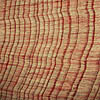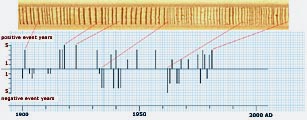 |
|
|
|
|
|
| What is dendrochronology? |
The principle of dendrochronology In temperate regions trees form a growth ring per year. Dendrochronology is based on the fact that characteristics of tree rings (ring width or ring density) reflect the environmental conditions during the growing period. A cross section from a tree therefore shows an irregular sequence of wide and narrow rings. This pattern or "finger print" is the same for trees growing at the same time and in the same region (e.g. larch trees at the alpine timberline). The age of a tree can be determined by counting the tree rings, and if the year of the death of the tree is known, the year in which each ring was formed can be dated in calendar years. If you have a living tree with 350 tree rings and you analyse the tree rings, you can determine very recent events like climate variations or geomorphological events. If you want to date events that occured many hundreds or thousand years ago, you have to establish extended tree-ring chronologies. This is only possible, if you have tree-ring series from a lot of trees with differnt ages from the same region and the same tree species. The following figure shows, how to construct long tree ring-chronologies with the so called cross dating method. |
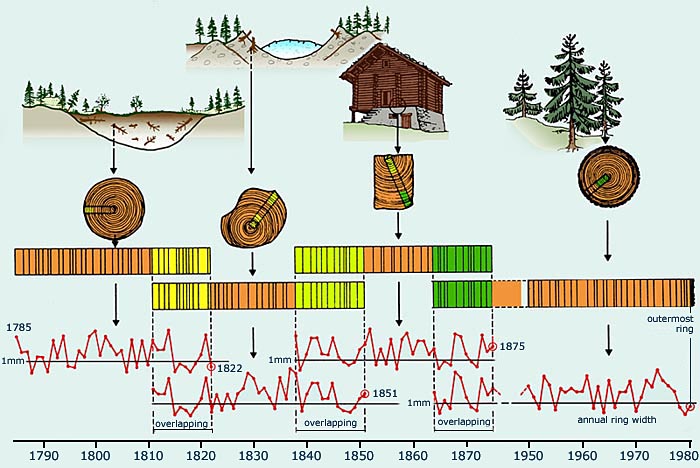
|
| 1 - In the principle of cross dating, you must first establish a tree-ring chronology using cores of living trees. If the inner rings of the living trees of known ages match with the outer rings of beams from an old building, the rings of the beams of unknown age are dated. The chronology is now extended further back in time. With this chronology you can date wood found in glacier forefields in the same way. Finally, wood that comes from peatbogs can be dated using the chronology constructed from the other sites. |
| |
|
http://tree.ltrr.arizona.edu/skeletonplot/introcrossdate.htm |
| The measurement of tree-ring width The measurement of tree-ring width is the most common technique in dendrochronology. Cores or discs taken from living or dead trees first must be prepared before the measurement. Cores are glued on wooden supports (Fig) and than sanded. On sanded discs, you choose a suitable place where the rings are well formed without irregularities caused by knots, decomposition or reaction wood. To measure the tree rings any optical instrument which can reproduce tree rings with an accuracy of 1/10 mm can be used (hand-lenses, stereo-mikroscopes). The obtained values can be drawn manually as a curve. Modern equipment consists of an optical part (stereo-microscope), sledge with spindle which is connected by an interface to a computer. The computer is programmed to print out the curves. With a special programm the curves can be compared and synchrosized with existing curves and chronologies. |
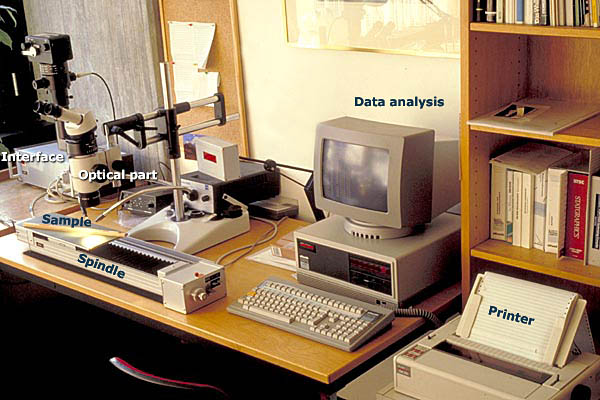
|
| 3 - A modern tree-ring measuring system. |
| Radiographic-densitometric measurement of wood density (Radiodensitometry) The measurement of tree-ring width radiododensitometry
requires a extensive X-ray equipment. Samples of wood are prepared carefully.
They must be sawed in laths of uniform thickness and then be putted on
film. Then the laths are ready for radiation. The resulting radiogram
shows the tree rings in different grey tones which correspond to different
wood density. The optical density of the film is then measured using a
microdensitometer. With that method a lot of annual ring features are
obtained (ring width, early- and latewood width, maximum and minimum density,
percentage of latewood). Radodensitometry is a very good tol both for
dating tree-ring sequences and palaeoclimatological reconstructions. Curves
of the maximum latewood density are highly correlated with summer temperatures
(August to September). |
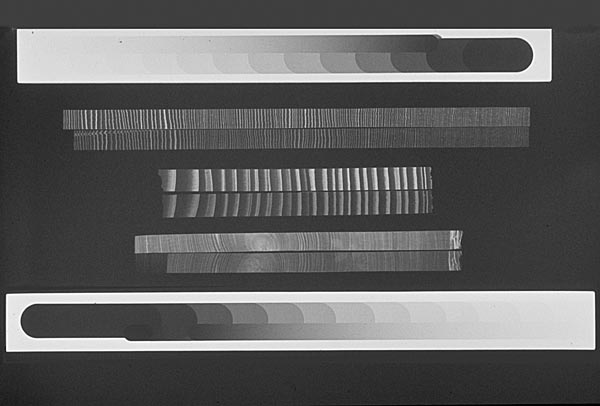
|
| 4 - A radiogramm of prepared
samples from cores. The different grey tones correspond to different wood
density. Density 0 is taken to correspond to the blackening of the underground
of the film. |
|
http://www.wsl.ch/land/dynamics/dendro/densitometry-en.ehtml |
| |
| |
| The calibration of radiocarbon ages Due to the circumstance that the 14C/12C
ratio in the atmosphere is not constant, radicarbon years are not
calendar years. With the help of dendrochronology a 14C age of a sample
can be calibrated into calendar age. By measuring the 14C concentartion
in long tree-ring series (up to 8000 to 900 year!) of known age (calendar
year) a calibration table is constructed (Fig). In this table a radiocarbon
age can be transformed in a range of calendar years. |

|
| 5 - Calibration curve between 3700 and 4300 BP after Pearson et al. 1986. In this table a radiocarbon age of 4100 ± 80 yBP is transformed into calendar years. |
|
| |
|
Schweingruber, F. H. A new dendroclimatological network for western North America. Dendrochronologia, 1988a Schweingruber, F. H. Tree Rings. Basics and applications of dendrochronology, 1988b Schweingruber, F. H and Briffa K. R. Density networks for climate reconstructions, 1996 |
|
http://web.utk.edu/~grissino/
|
29 August 2011 |
||
| |
||
